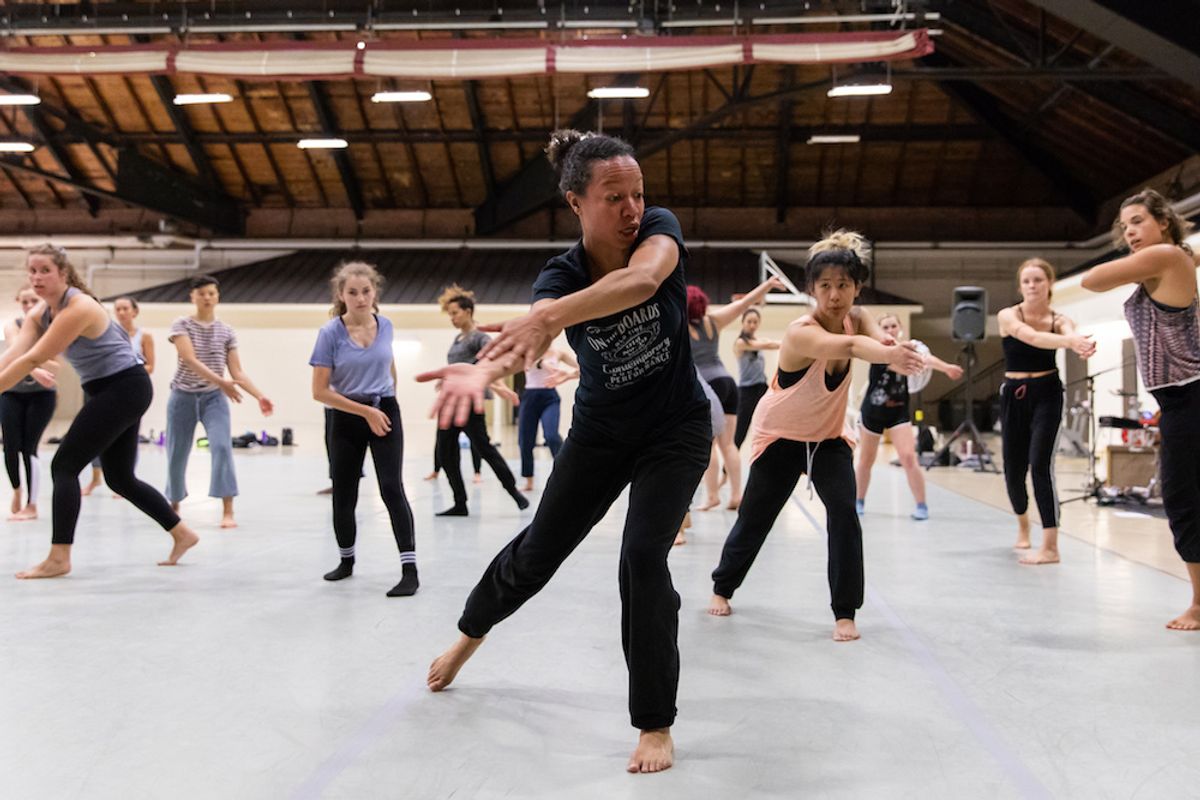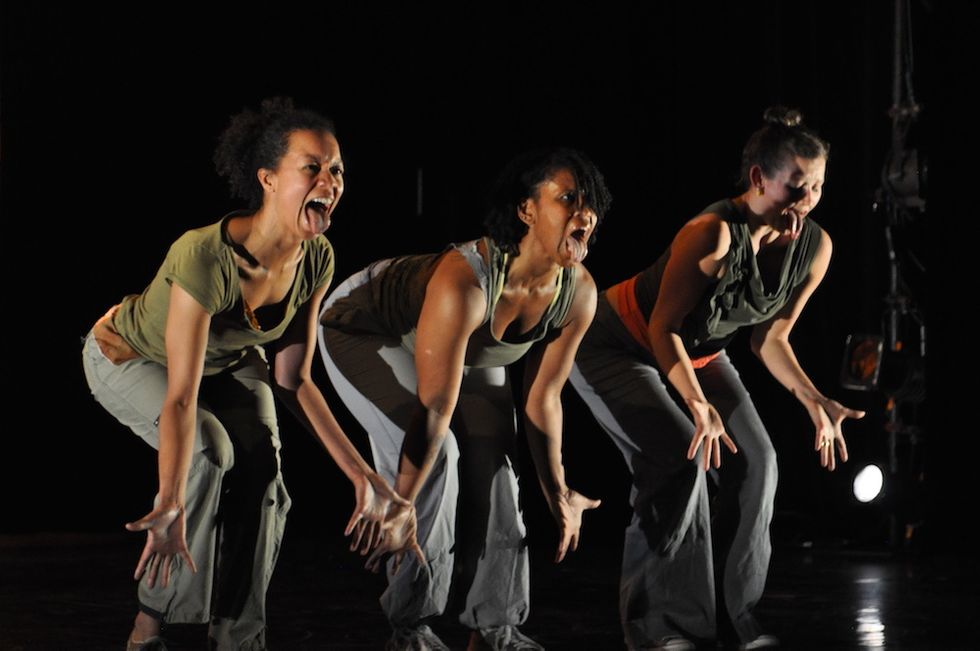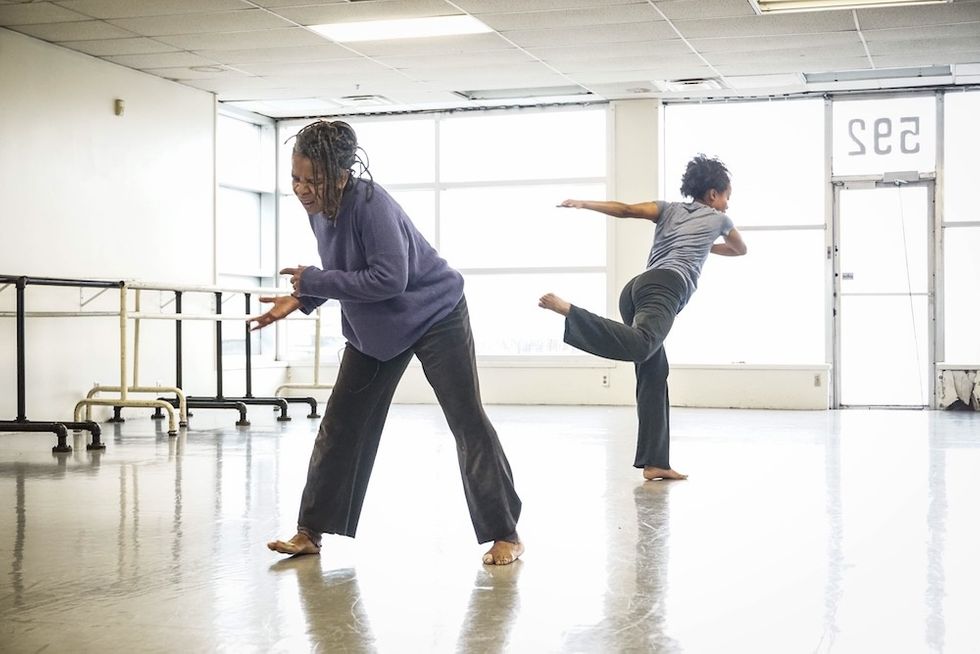
Gesel Mason has serious chutzpah. Eighteen years ago, fresh off a performance career with the Dance Exchange and eager to focus on her own work, she decided to ask some high-profile African-American choreographers—Bebe Miller, Andrea Woods Valdés, Jawole Willa Jo Zollar, Donald McKayle, David Roussève—if they’d set solos on her. “It was one of those moments where you don’t realize what you’re asking,” she says. “Before I got too in my head, too ‘Why-would-I-even-dare-to-ask-these-people?’, I just…did.” In looking back, she’s surprised they all said yes.
That was the beginning of No Boundaries: Dancing the Visions of Contemporary Black Choreographers, an evolving collection of solos meant to show the resilience and diversity of black contemporary performance. “The work very clearly shows that, actually, the boundary of the term ‘blackness’ doesn’t really exist. It’s wide and risk-taking and sophisticated,” says MK Abadoo, a friend and colleague who has performed with Mason.
Since 2001, Mason—while also creating her own work, directing a company and holding teaching positions at many universities—has steadily amassed 11 solos, embedding herself in these choreographers’ processes. Now, No Boundaries is evolving once more. Mason is archiving videos of the solos and extensive interviews with their respective choreographers via an online platform that will go live this spring, as part of her new (as of fall 2018) position at The University of Texas at Austin.
“Mr. McKayle, by the way…”
Though she admits to some initial naïveté when asking choreographers if they’d work with her, Mason was strategic about who she asked. She mostly approached people “who I’d had some sort of interaction with,” she says, whether that was through her time performing with Liz Lerman’s Dance Exchange in Maryland or via one of Mason’s own projects. Some interactions were calculated—what she jokingly calls “soft stalking.” “I totally did that with Jawole,” she says, as an example. Mason went to an audition for Urban Bush Women and spoke to Zollar afterward about the solo project. “With Mr. McKayle,” she says, “I saw that he was going to be at the American Dance Festival, so I signed up for the professionals’ workshop and took his class. And then I went up to him and said, ‘Mr. McKayle, by the way…'”

Mason with Mecca Madyun and Erinn Liebhard in Rennie Harris’ “You Are Why!”James Forsberg
Mason conducted extensive interviews with each choreographer who set work on her. “I was asking, ‘How is it that they make the work that they make? Why? What’s their dance lineage? Who are they as people?'” she says. “Because that was something folks didn’t necessarily know—what you don’t get to see onstage. It’s a window into their lives.”
Mason also made a concerted effort to choose black choreographers who represented a wide spectrum. “I started with women choreographers,” she says, “and then wanted to get back to male choreographers. I had some young choreographers, and then I wanted to get some people who had some connection to Alvin Ailey’s time period—that was Donald McKayle, later on Dianne McIntyre—since I was interested in a generational spread.”
“I don’t know if I can pull this off.”
Learning each solo was an intensive process. Mason would travel to the choreographer and spend between five days and a week, four to six hours a day, committing the movement to memory. “The biggest thing was not ever assuming that I ‘had’ it,” she says. “You have to really remember the nuances and the detail and take the notes and watch the video.” But it was often time spent outside the studio that she considered the most meaningful. “What was cool was that, for example, Dianne McIntyre drove me around Cleveland,” says Mason. “I’d go out to dinner with these folks and wish I had the camera with me—all of the other stuff I saw that’s part of a choreographer’s life and making dances was so exciting.”
Each solo presented its own challenges. Sometimes they were physical; often, they were emotional. “Each had its thing, where I was like, ‘I don’t know if I can pull this off,'” Mason says. “David Roussève was so specific; he was choreographing my pupils. With Dianne, there were things I couldn’t get, to the extent that she said, ‘Let’s scrap that and start over.’ For Bebe [Miller], my center of gravity was not in the same place as hers. Andrea Woods—she’s 5’9″ or something and has a super-long Achilles. I don’t have that. Reggie Wilson’s piece was 20 minutes—that’s the longest solo of all. It was about surviving sexual assault. I had to go through these different states.”

With Bebe Miller. “My center of gravity was not in the same place as hers,” says Mason.Jess Cavender
And then there was the emotional toll of performing the work. Over the 14-year performance term of No Boundaries, Mason performed various combinations of the work at venues like Dance Place in DC (2004, 2006 and 2015), Joyce SoHo in New York (2007), Links Hall in Chicago (2008) and the Painted Bride Art Center in Philadelphia (2009). Yet it wasn’t until her friend (and University of Florida dean of the College of Arts) Onye Ozuzu asked how she was handling it that Mason even gave that aspect a thought. “She was like, ‘Who do you have backstage helping you with the emotional labor?'” says Mason. “I said, ‘um…'” Eventually, she recruited Abadoo for this role and adapted her backstage regimen accordingly. “I had my foam roller,” says Mason. “My walnuts, my oatmeal. MK asked, ‘What kind of music do you like to listen to? What are your favorite scents?’ She’d have lavender and vanilla backstage. We’d do meditation practices together.” That approach particularly came in handy when Mason learned Donald McKayle had passed away 30 minutes before she performed his solo, Saturday’s Child. “That was a huge shock,” she says. But she was able to access an even deeper level of investment in the piece and the project at large. “I felt like, ‘This is the reason that I’m doing this,'” says Mason. “What a great way to celebrate his life—by performing his work.”
“I started to imagine what the No Boundaries archive could be.”
In April 2018, Mason performed seven of the solos at the Billie Holiday Theatre in Brooklyn—for the last time, she vowed. “The idea was to capture these solos with a multicamera shoot, to get the best footage,” she says. That performance footage comprises an important part of her No Boundaries online archive, a project that UT Austin offered considerable support for—which played a big part in her decision to move from Colorado to Texas. “They have really established archives and libraries here at UT Austin,” she says. “I started to imagine what the No Boundaries archive could be, other ways that this work could live on.”
At UT Austin, Mason works with a growing team, including archivists and African-American historians, who are helping her transition from what’s been primarily a physical performance archive to a digital one. “Sometimes, we forget that dance is of the moment. When we think about anthropology, dance is the reflection of a culture. I’m curious how these solos translate, how they point to something larger.”

Jess Cavender
Now that the project has evolved, there are new questions for Mason to address. “I’m not handing a box of material over to somebody,” she says. “I’m the one doing the shaping—the one who’s giving the audience what they’re going to see. What’s going to tell the story?” There’s also been the experience of seeing her body change over the last 15 years. “I’m not 15 years younger,” says Mason. “What does it mean to be a physical repository that’s degrading? How do you then keep the essence or story alive when these things are literally slipping through your fingers?”
“I still recognize how important it was, the live performance,” she says, noting how rare it would be to see seven African-American choreographers featured in the same program. She’s hopeful the archive will spark inquiry and study for generations to come. “Maybe it’ll be a repository for African-American work—a go-to place,” she says. Right now, she and her team are still figuring out what the user experience of the archive will be. “We’re thinking about having a little icon that’s me, where you click and watch how I learned a piece,” she says. “Or you can have your own journey: I have hours and hours of interviews with Rennie Harris. I’ll show you five minutes, but you could also go in and watch unedited footage of him talking.”
The archive isn’t the only reason she chose UT Austin. She’s also helping to shape the university’s new master’s program in dance and social justice. “I was like, ‘That has my name on it,'” she says. “It was exciting, coming in on the ground floor of something new.” She also developed a legacy class in relation to the No Boundaries archive. “What does it mean to be archiving this material? Who gets to tell that story? How is gender embedded in the archiving system? Who has access to the material?” she asks. “As artists and storytellers, the body is an archive. You’re performing the archive, embodying the archive, becoming a dancing legacy.”




